Good Morning, Vietnam
After I arrived an Hanoi, I was thrilled that the awful 25-hour bus ride spent sitting in a plastic stool was finally behind me. Well, almost behind me.
On my first few days in town, my brain did its best to enjoy and absorb the chaotic madness of the place, but my body refused to forget the pain and agony of the bus ride. Despite my best efforts to avoid inevitable sickness, I eventually ended up in bed sniffling, sneezing, coughing, with an achy head and fever, just wishing I could rest. Someone should invent a medicine to relieve these symptoms, but no such medicine exists.
Luckily, my room was equipped with a TV, so I settled in for a few days of channel surfing. There was plenty to choose from: the wacky Vietnamese news, the English-language propaganda channel from China, Bollywood soap operas from India, and a hilarious Russian talent-search channel. But I finally settled on an old favorite: a little station called MTV. And for the first time in a while, I experienced a serious case of culture shock.
I never noticed before, but virtually every show on MTV is about flaunting money. And when you've spent the day wandering around Vietnam, the contrast between MTV and reality is amplified. On The Hills, ultra-rich blonde girls from LA wander around LA shopping and partying, ditching their university classes, half-assing their jobs, and complaining about how tough their lives are. On Pimp My Ride, a kid jumps up and down with glee when he sees the Xbox and plasma TV the crew just installed in the trunk of his crazy new car. On TRL, video after video shows rappers flashing their bling to the camera. We all know that America isn't really accurately portrayed on MTV, but I started to wonder — do other people? Do they think this is how we actually live? I've met countless people throughout this trip that have shared with me their dreams of moving to America. What Hollywood-skewed vision of America do they have in their minds? Do they know that real life in America is mostly just a lot of driving and working?
After my sickness subsided, I snapped out of my sickly haze and was out exploring the streets of Hanoi. From other travelers, I've heard nothing but horrible things about Vietnam and especially Hanoi. After going there, I can tell you with absolute certainty: those people are idiots. Hanoi is awesome.
First of all, the traffic in Hanoi is some of the craziest I've ever seen. The streets of the old quarter are choked with motorbikes each speeding along while masterfully avoiding collisions. At every street corner, I'd stop to admire the chaos of the intersections. Here's a video to give you a feel for an average intersection in the old quarter:
And if that wasn't enough, this one shows you the staggering number of motorbikes on a major street. Watch how quickly the traffic transitions after the stoplight changes.
Aside from traffic, Hanoi's massive old quarter is an endlessly interesting web of disjointed streets and alleys. Every available space is used for something. Sidewalks are packed with vegetable markets, the contents of shops pour out into the streets and cling to every wall, and tiny stools packed with young people gather around hundreds of steamy street food options. Roving pointy-hat-wearing vendors from outlying rural areas ply the streets hawking fresh tropical fruit. Photos of former communist leader Ho Chi Minh still gaze down from many walls around town. Like other parts of Southeast Asia, Hanoi has a ton of leftover colonial architecture from the city's days as a part of French Indochina. I found Hanoi's buildings even more interesting, because each one is about five stories tall, but only about ten feet wide, giving them really unusual vertical proportions. Each street in the old quarter is named after the specific good that was historically sold there (i.e. Spice Street), and although the shops on each street are a bit more diverse now, many of the old names still ring true and remain easily identifiable. Here's are some products for sale on Gravestone Street:

A few months ago, I read an article in the New York Times raving about Hanoi's booming contemporary arts scene, so I spent a couple of days checking out the huge number of galleries around town. A lot of the paintings successfully blended western influence with eastern style without being gimmicky or reactionary. The art was definitely some of the best I've seen in Asia, and left me feeling refreshed and inspired after the temple-temple-temple routine that's tough to avoid while traveling in Asia.
I also stopped at the Hoa Lo Prison — better known as the Hanoi Hilton — where American prisoners of war were held between 1964 to 1973 until their release as the US pulled out of the Vietnam War. Most of the exhibits at the prison, now converted into a museum, revolved around the disturbing torture of Vietnamese inmates by the French back in the Indochina days. In contrast, the two small rooms dedicated to the American imprisonment were very flowery and made the Vietnamese captors look like compassionate saints. Look at the Americans playing cards! Doesn't that look fun? Look at them eat big meals! Delicious! Look this picture of a soldier smiling! Isn't prison the greatest? It was pretty far removed from the stories of torture and humiliation we've all heard about from the American POWs, but it was definitely interesting get a feel for the Vietnamese perspective. There were a handful of photos of the American soldiers who were imprisoned at the Hanoi Hilton, including some guy named John McCain, who I heard is running for some political office back in America— city mayor or something, right?

Although the language barrier mostly prevented me from talking with local people about the American war with their country, I was surprised at how distant most people seemed from it. More than 60% of people in Vietnam were born after the war was over, and young people seemed more interested in shopping, eating and going to school than they did in reliving the war. Considering that Vietnam was constantly at war for the bulk of the 20th century, I don't blame them. At one of the many great propaganda poster stores around town, I couldn't help having pretend conversations inside my head with the employees, who were all about my age.
Isn't this weird?
What?
That if we had born 30 years ago, I would be your enemy.
Yes.
I would be hunting you. Trying to kill you.
And I would be hunting you.
Instead you're trying to sell me propaganda posters.
Anti-American posters, yes.
Is this better?
Of course. Nobody dies this way.
Fair enough.
On my last day in the Hanoi area, I took a day trip out to Halong Bay, famous for its curvy limestone peaks jutting out of the water. Most people spend a few days sleeping on a boat, but I opted for a day trip because I still had a wicked cold and I wasn't feeling up to it. A bunch of us piled into a boat for a short tour around the gorgeous misty scenery, visiting a few enormous caves and a floating fishing village along the way. March is apparently the worst time to visit the bay, so the conditions weren't really ideal, but I thought it was still pretty damn impressive.

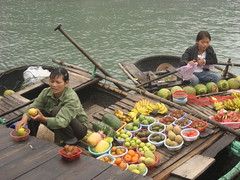

After a week soaking up everything in and around Hanoi, I decided to continue my northward push on a night train up to Sapa, a small Vietnamese mountain town famous for ethnic minorty villages and spectacular rice terraces. Although it's probably one of the top-three tourist areas in the country, Sapa wasn't a letdown at all. I stayed in a family-run hotel which was recommended by my friend Leila way back in India, and it turned out to be one of my favorite hotels of the trip. The family kept me well-fed and full of tea, and treated me like I was a long-lost cousin. The view from my room was a kick-ass panorama of the valley below and misty mountains beyond. Check it out:
Yes, I actually made an appearance in one of my videos. No, I'm not intentionally growing a beard, I'm just lazy.
The main part of town is packed with ethnic minority people, many of whom try to sell blankets, instruments and jewelry to tourists. The minority girls I talked to were hilarious, and I spent a lot of time chatting with them about their lives. There was a noticable tension between the ethnic Vietnamese and the area's minority villagers, and the impression I got from the girls was that in the past the minority communities were treated realy poorly by the Vietnamese. Lately, the tides have turned a bit in favor of the minorities — since tourism started heating up in the area ten years ago, the minority communites have been legitimized both in community status and financial security. Conversation was easy, because most of the minority girls spoke unbelievable English considering they had never been formally trained; most of them just picked up English by talking to foreigners every day. Here are a few of the charming villagers I befriended during my stay in Sapa:

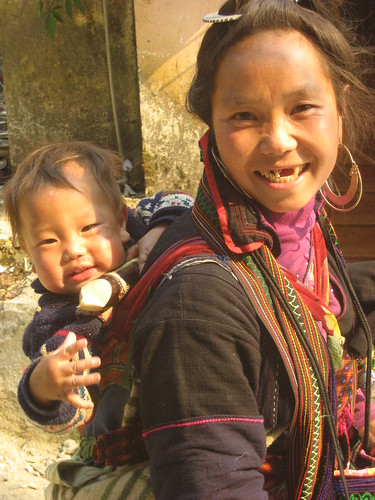
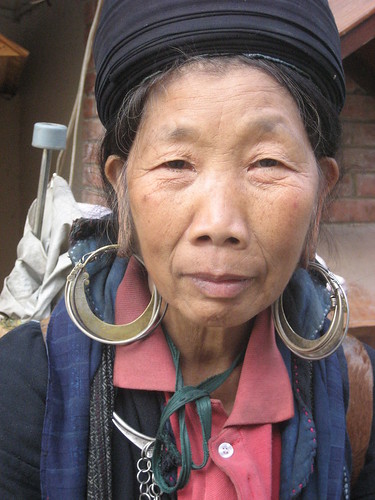
I took a few day-hikes out into the villages surrounding Sapa, which are situated among the incredible rice terraces carved into every surface of the hillsides. With the endlessly hilly terrain, local farmers have no choice but to labouriously cut into the mountains in an attempt to create flat land. The result is some of the most incredible scenery I've ever seen. I loved getting out of town on my own where I could look out onto the terraces and watch the villagers go about their daily lives down below.

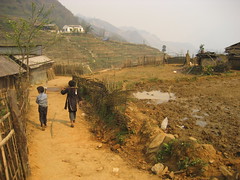

After a few days, I left Sapa early in the morning and crossed the border into China before noon, making a quick stop in the border town of Hekou, which wasn't quite as sketchy as most border towns, but was still filled with the requisite oddballs and prostitutes.
Very immature side note: my favorite thing about Vietnam is that the currency is called "dong" which means you can say "dong" constantly in situations where it ordinarily wouldn't be appropriate. Speaking of which, will you hold onto my dong for me while I go to the bathroom? Anyway, two weeks worth of dong jokes really pleased the part of me that never wanted to leave seventh grade. That part of me is also excited about being able to start sentences with "Back in Nam..."
From the border, I caught the night bus north to Kunming, the capital of the Yunnan province, and was dumped off there early the next morning after a fairly comfortable ride on a Chinese sleeper bus, which have midget-sized bunkbeds instead of seats. My plan was to continue the relay race and catch the afternoon train all the way up to Shanghai, but the train station was sold out of hard sleeper tickets for another nine days, throwing a major monkey wrench in my plans. I settled on the only thing they had left — an expensive ($100!) ticket aboard the 1st class soft sleeper train leaving two days later.
Without a China guidebook, I started to wander around Kunming looking for hotels and stumbled upon the crazy-popular Camelia Hotel, a backpacker favorite for its excellent dorm beds for only $3.50 per night. Stuck in town for a few days, I decided to settle in and check out the city. I had actually been to Kunming and other parts of Yunnan before, on my trip to China to visit my brother Bill after he moved here five years ago. Although most people outside China have never heard of it, Kunming is home to 3.8 million people — about the same amount that live in Los Angeles. It is one of the nicest and most livable cities in China, and has a lot of really nice pedestrian-oriented spaces, a few great temples, and lots of green parks.
My favorite free activity in Kunming was to hang out in the city's great public park, where people of all ages come to have fun. There were old people performing traditional opera to big crowds, tons of vendors selling great street food, a man expertly hitting notes as he played a piece of grass with an accompanying band. My favorite was the group of middle-aged couples learning the cha-cha, which was pretty hilarious — Won! Two! Sree! Cha-cha-cha! Here's a shot of a big group of people preparing for their reenactment of the Michael Jackson Thriller music video. Oh man, I wish.

Like in most places, I spent most of my time in Kunming aimlessly wandering. I must have wandered right past the ticket booth at the zoo, because suddenly I found myself surrounded by bears and lions. I quickly realized this wasn't a regular zoo, but rather, an awesome Chinese zoo. You see, there are apparently no rules at Chinese zoos, and you can do pretty much whatever you want to the animals, so there is a lot of interaction. You want to yell at the bears and try to get them to do tricks? Cool! You want to throw an ice cream cone in the cage and watch the lion tear it apart? No worries! It was pretty awesome, and the animals were going absolutely bananas compared the animals at the boring ethical zoo back home. There was also a dangerous-looking amusement park next door, which definitely added to the delightful zoo's allure.
Here are some scenes from around Kunming — the river which bisects downtown, a bridge at an amazing temple I visited, and some kids on the ride at the zoomusement park.

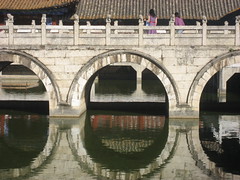

After a few days, it was time to use that first-class train ticket, and finally get myself to Shanghai. Despite my awesome compartment on the train, the 43-hour trip was pretty agonizing. The only other person who spoke English on the train was an 81-year old Chinese man who recently went deaf, which obviously made the conversation a bit one-sided. In typical Chinese fashion, people had their eyes locked to me for the entire 43 hours, which is not something I will ever get accustomed to. I mostly just read, listened to music and stared out the window as the scenery changed from the blue sky and minority villages of Yunnan to the gray industrial wasteland that dominates the center of the country. Here's a picture of me on the train. Look at that glorious expanse of space! First class indeed.

My brother Bill met me at the Shanghai train station, and we jumped onto the subway and sped off to his apartment, which is located next to a cool mixed-use development with shops, bars, and restaurants aplenty. When I visited Bill and my sister-in-law Vivien at the beginning of my trip, they lived out in the boonies an hour outside the city center, and now they live right where all the action is. I've spent most of my time here so far going out to dinner with their friends, sleeping as they get ready to go to work, checking out the city on my own, chipping away at their massive DVD collection, and enjoying Nanjing Road, the city's major pedestrian street:

I also went to the brand new Shanghai Museum of Contemporary Art, which is running an excellent exhibition of interactive art pieces. Most of the work was really creative. I especially liked the portraits of people you could affect by calling a number on your cellphone. I also loved the one below, where you could record a three second clip of yourself, which would then be added to the end of a fast-motion series of every other clip recorded at the museum. Here's a video so you can get an idea:
At the top of my to-do list in Shanghai was to get a Russian visa, so I headed down early in the morning a few days ago to go get one. Once I found my place in line outside the Russian Consulate, I noticed that the building also serves as a school for all the consulate employees' children. It's a bizarre feeling to wait two hours outside what seems like some mysterious Russian fortress only to watch some eight-year-old with a Pokemon backpack give the guards a casual nod and waltz in like he owns the place.
A Russian visa is notoriously difficult to obtain and I spent a lot of time online researching exactly what documents I needed to bring with me. For starters, the consulate is only open to visa applicants for nine hours per week, so you have to time it just right. Also, Russia requires you to be invited into the country by someone, which poses a challenge for independent travellers. Naturally, hundreds of websites have popped up where you can pay $35 to get invited, and they'll instantly send you an official invitation via email. Once inside the consulate, I proudly handed over my mammoth stack of documents, confident that I had everything perfectly in order. I had figured out the system.
Okay Mr. Nee, everything looks fine. That'll be 150 dollars.
Wh... uhh... what? Are you sure?
Yes, I'm sure.
I thought it was only 50 dollars?
That is the fee for everyone else. For US citizens it is 150 dollars.
Oh my god. Wha... oh... okay... uhh...
Do you want to get the visa?
Umm... I don't... I don't know....
Sir, you must either pay for the visa, or step out of line.
I stepped out of line. I felt like someone had slapped me in the face with a bag full of bricks. For the last few weeks, I've been trying to come to grips with the fact that Russia is the most expensive country on earth. Hotels there are expensive, getting into the country is expensive, and food is expensive. Who would have thought that Siberia would be more expensive than Tokyo or London? What happened to days of bread lines and the old babushka ladies with the headscarf and unsightly mole? To give you some perspective, I've been able to live for about 20 dollars per day throughout most of Asia, and it's looking like Russia will cost more like 75 dollars per day — substantially over my maximum daily budget. The two weeks that I was planning to spend in Russia will likely cost me more than the two months I spent in Myanmar and Nepal. Is it really worth it? Should I figure out another plan?
After some discussion with Bill and Vivien and some research online about the cost to just fly over Russia, I eventually decided to just not worry about the money and just go ahead with my original plans. On my second visit to the consulate, it turned out that the visa actually only cost $100, so that made me feel a little better. So I'm going to Russia after all — but first, some more time in Shanghai and then on to Beijing.
Well, that should give you enough to read until I return in August. As you can probably imagine, updating the blog is a serious undertaking, so I really appreciate so many people reading it. Thank you!
Ryan!
4 Comments:
I'm so jealous that you are going to Russia! Homeland of the Aronowitz's. My grandma was telling me all these stories the other day of our Russian relatives. I can't wait to see your pictures! Have fun!
In communist Russia, blog writes you!
nice whiskey-and-cigarettes voice. it suits you.
russian subway photos seem to be popular. is it really this wacky all the time?
hey, i took the bus ride from hell the other direction (hanoi to laos) and it was just as crazy. it happened to be a public holiday weekend and it was said to be even more crowded than usual. some people stood in the bus the entire 20-odd hours and we arrived in vientiane smelling like goose.
love your blog!
Post a Comment
<< Home